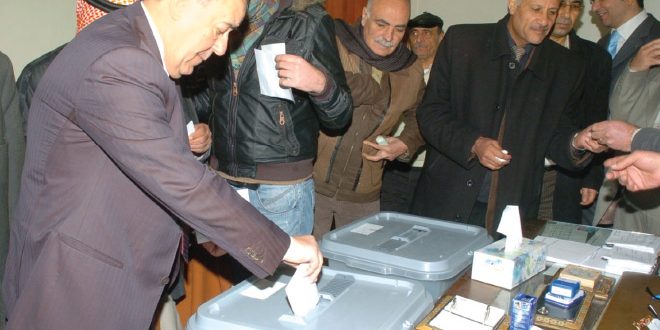The President of the High Elections Committee, Suleiman al-Qaed, said that elections are a right and a duty for every Syrian citizen and Kurds who are Syrian citizens in accordance with Decree No. 49, which gave those on the foreign registry in Hassakeh Syrian citizenship, and therefore the right to run and vote in local administration elections.
In a statement to Al-Watan, Qaed revealed that the electoral districts for the local administration elections had been determined in the city of Hassakeh and in Qamishli, Afrin and Ayn al-Arab.
Qaed added: If any electoral procedures cannot be carried out in hotspots such as Afrin, the committee can transfer the electoral centers to other areas. He said that Article 59 in the Elections Law permitted the committee, when necessary, to transfer electoral districts or centers to other districts, and that the same was true for transferring vote counting.
Qaed believed that the turnout of Kurds for the elections would be related to the ease of movement, especially in areas which are occupied by Turkey or the Syrian Democratic Forces (SDF). He expressed his optimism that there would be broad participation from Kurds and thus a rejection of any idea related to self-rule.
Qaed said that Decree 49, gave Kurds the rights and duties which they must be granted like any Syrian citizen, including those pertaining to local administration elections.
Qaed said that the ease of movement was not linked to the occupied majority Kurdish areas but to other regions such as Idleb and Raqqa, and that this poses a big challenge. He said that Syria was divided into 85 electoral districts.
Qaed said that Damascus and its countryside had been divided into 16 districts, five in the city and 11 in the countryside. Aleppo had been divided into 15 districts, four in the city and 11 in the countryside.
Qaed added that Homs had been divided into seven electoral districts and Latakia into five. Tartous had been divided into seven, Deir ez-Zor into three, Hassakeh into six, Daraa into six, Suweida into three, and finally Quneitra into one district.
Qaed said that electoral districts had been determined for Idleb and Raqqa provinces but that it had been determined that the elections would be held in the province of Hama, adding that it was possible that election centers would be put in the liberated Raqqa countryside.
Qaed said that the placement of centers in areas that were recently liberated by the state would be tied to the security situation, in addition to the return of services. For example, in Daraa province, it would be possible to run elections in the area where reconciliations had been achieved, and events had calmed down, including the security situation. He expected the elections centers in these areas would be in Daraa city.
Qaed said that Decree No. 2 issued in 2016, which extended the local councils was still in effect and therefore it was possible for the local councils to remain as they were if there were no elections held in a certain area. He said where election procedures could not be held, then the centers would be transferred to another area.
Qaed said that the determined location of the voting centers would occur seven days before the date of the elections, with the branch committees selecting them.
Qaed said that the law specified conditions for voters and candidates, saying that those who carried out felonies could not vote as they were stripped of their right, while those who carried out scandalous misdemeanors such as fraud or prostitution could not run.
This article was translated and edited by The Syrian Observer. Responsibility for the information and views set out in this article lies entirely with the author.


